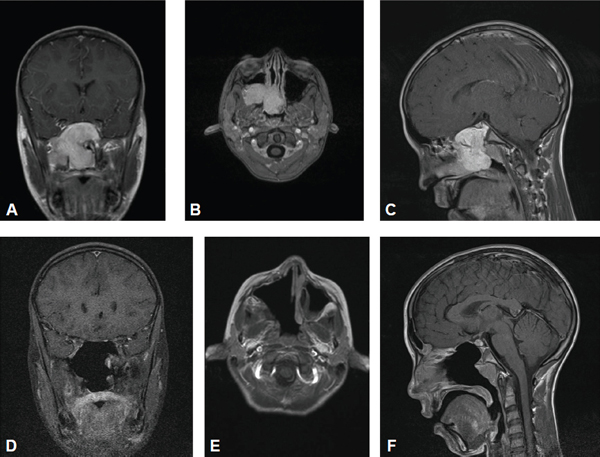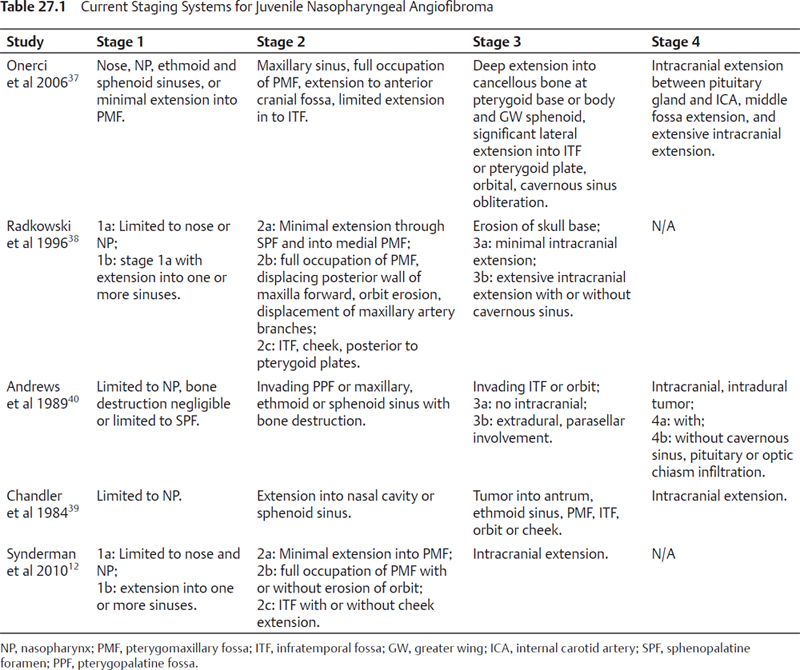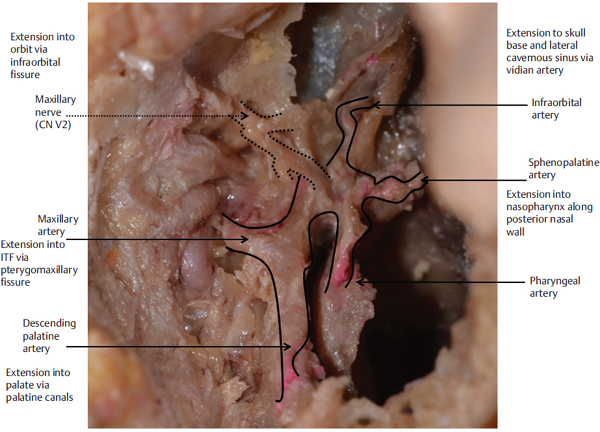27 Endoscopic Surgery for Juvenile Nasopharyngeal Angiofibroma Juvenile nasopharyngeal angiofibroma (JNA) is a benign vascular neoplasm, the etiological origin of which remains elusive.1 Although typically slow growing, these nonencapsulated tumors are locally aggressive, with potential for intracranial or intraorbital extension. JNAs typically arise from the posterolateral wall of the nasopharynx and grow by extrusion via natural ostia. Advanced tumors often assume a dumbbell-shaped configuration, with one portion of the tumor occupying the nasopharynx and the other portion reaching into the pterygopalatine fossa (PPF).2 Intracranial extension occurs in approximately 10 to 20% of patients.3–5 JNAs typically derive their blood supply from the ipsilateral internal maxillary artery, a branch off the external carotid artery (ECA); however, bilateral supply and communication with the internal carotid are relatively common. Wu et al describe bilateral vascularity in 36% of patients; with ipsilateral internal carotid artery (ICA) contribution present in 10% of cases.6 Up to one-third of tumors have contributions from the ascending pharyngeal artery as well. As JNAs expand, they may also recruit additional blood supply from the ophthalmic and contralateral internal maxillary arteries. JNAs are rare, representing a mere 0.5% of head and neck tumors (approximate incidence = 1:150,000),2,4,7 and occur almost exclusively in adolescent male patients. Isolated cases of JNAs have been described in female patients and older men.8,9 The most common presenting symptoms are epistaxis and progressive nasal obstruction; most patients present concurrently with both symptoms.10 Other presenting symptoms include nasal discharge, pain, sinusitis, otologic symptoms, visual loss, facial deformity, facial hypesthesia, diplopia (from cranial nerve compression or from direct orbital compression), and proptosis. At the time of presentation, a red-to-purple nasal mass may be visible upon gross inspection of the nasal cavity.11 Work-up for suspected JNA begins with in-office endoscopy, followed by radiographic imaging typically including both computed tomography (CT) and magnetic resonance imaging (MRI) modalities. CT scans are preferred for assessment of the extent of bony invasion (Fig. 27.1), while MRI provides superior visualization of the soft tissue of the tumor itself as well as of adjacent structures such as the ICA, cavernous sinus, and pituitary gland (Fig. 27.2).11 The Holman-Miller sign—anterior bowing of the posterior maxillary wall—is considered pathognomonic for JNA. Angiography provides further confirmation of the diagnosis to allow for concurrent preoperative embolization (Fig. 27.3).11 Biopsy confirmation of the histological diagnosis is not performed until in the operating room, after embolization, because of the extensive vascularity of these lesions and the potential for significant bleeding. Figure 27.1 Computed tomography scan of a giant juvenile nasopharyngeal angiofibroma. Note the boney destruction of the maxillary sinus with direct extension into the infratemporal fossa. Surgical resection is the definitive treatment modality for JNA and is largely considered curative, although recurrence may occur in a minority of patients.9 Preoperative embolization is typically performed 24 to 48 hours before the scheduled surgery to decrease intraoperative bleeding risk. In the past, resections of JNAs have typically taken place via open approaches. However, endoscopic approaches are quickly becoming a treatment of choice. An incision-free approach obviates the risk of growth center disruption and facial asymmetry in this young population. Furthermore, evidence suggests that endoscopic techniques may decrease operative time, blood loss, and need for transfusion, although definitive data are lacking.9 This review will focus on endoscopic techniques and outcomes for JNA. We will also discuss potential future adjuncts to surgical treatment through genomic and hormonal translational research. Figure 27.3 Angiography of a giant juvenile nasopharyngeal angiofibroma. (A) Pre-embolization external carotid artery (ECA) with significant tumor blush from the ECA system. (B) Postembolization angiogram with significant decrease in ECA blood supply. (C) Internal carotid artery angiography with inferior-lateral truck blood supply. This could not be embolized because of it being from the internal carotid system. This was controlled with clipping and bipolar cautery intraoperatively. Several staging systems have been proposed and modified to classify JNA and most of these are based on the extent and location of the tumor. The three main staging systems are outlined in Table 27.1. The Radkowski system is the most widely used system for JNA classification, dividing tumors into three distinct groups (Table 27.1). The primary limitation of these older staging systems is that they were not designed for endoscopic approaches. Thus, Snyderman et al at the University of Pittsburgh Medical Center (UPMC) published an endoscopic staging system for JNA.12 They noted that tumor size and the extent of sinus disease are less important in predicting complete tumor removal with endonasal surgical techniques. The UPMC staging system for JNA accounts for two important prognostic factors: route of cranial base extension and residual vascularity after embolization (often signifying the presence of internal carotid or bilateral blood supply). Compared with other staging systems, Snyderman asserts that the UPMC system provides a better prediction of immediate morbidity (including blood loss and need for multiple operations) as well as tumor recurrence (Table 27.1).12 As one considers an anterior endonasal approach, it is crucial to bear in mind the relative anatomic position of the origin, as well as the spread of JNAs (Fig. 27.4). JNAs typically originate in the area of the sphenopalatine artery (SPA) and in the area of the PPF. Most commonly, the presenting symptoms are both epistaxis—resulting from the weeping of blood from this vascular tumor supplied by the sphenopalatine arteries—and nasal congestion, related to the blockage of the choana. It is important to understand the complete anatomic relationship of the PPF to be fully able to appreciate complexities involved in the resection of a JNA, as well as to be able to maintain vascular control during the procedure. The PPF is a small pyramidal space that is limited by the posterior wall of the maxilla on its anterior surface and by the pterygoid plates along its posterior surface. The ascending process of the palatine bone defines the medial boundary and its lateral boundary is the pterygomaxillary fissure, a soft tissue space separating the PPF from the infratemporal fossa along a sagittal plane at the level of the inferior orbital fissure. The pterygomaxillary fissure transmits the internal maxillary artery from the ECA into the PPF. The anterior portion of the PPF contains the terminal division of the internal maxillary artery, the terminal branches being the palatine arteries, SPA, and posterior nasal septal artery. It also gives off an infraorbital artery that runs with the maxillary division of the trigeminal nerve (V2), as well as a small perforating blood supply to the soft tissue components within the PPF. The posterior compartment of the PPF contains V2, the vidian nerve, and the sphenopalatine ganglion and its terminal branches. In an anatomic dissection published in The Laryngoscope,13 all neural structures of the PPF were located posterior to the SPA and lateral to the sphenopalatine foramen. This configuration allows access to the vascular structures of the PPF when dissecting in an anterior to posterior direction from an endonasal approach without direct damage to the nerves residing in the posterior compartment. It should be noted that the number and course of the palatine nerves, as well as the branching pattern of the SPA, are often multiple and variable, ranging from two to seven branches.14 Figure 27.4 Juvenile nasopharyngeal angiofibroma potential routes of spread via the pterygopalatine fossa (PPF). Shown is a cadaveric dissection of the PPF with arteries and nerves labeled. Extension into the infratemporal fossa, orbit, palate, nasopharynx, and lateral cavernous skull base are shown. Understanding the relative spread outside the PPF for surgical dissection requires a comprehensive grasp of (1) the anatomy of the PPF, (2) the JNAs origin therein, and (3) the propensity of JNAs to spread directly through natural anatomic pathways rather than through destructive invasion. Common routes of direct extension beyond the PPF include: • Extension into the orbit via the infraorbital fissure, • Extension into the infratemporal fossa via the pterygomaxillary fissure, • Extension into the middle cranial fossa (by traveling through the infraorbital fissure to the foramen rotundum or through the foramen ovale from the infratemporal fossa), or • Extension into the anterior cranial vault via direct extension through the ethmoid cavity. Tumors invading the anterior cranial vault by this last route often accumulate blood supply from the anterior and posterior ethmoid arteries and extend into the planum sphenoidale or the ethmoid roof. Occasionally, extension into the palate can be seen through the descending palatine canals; however, these very small bony channels tend to be more resistant to direct spread of JNA than the orbit, infratemporal fossa, middle cranial fossa, and anterior cranial vault. Of note, while this tumor type usually pushes boundaries rather than directly invading them, in rare cases it can invade through the periorbita or the dura. Particular anatomical considerations in the infratemporal fossa include the substantial and variable blood supply coming from multiple branches of the ECA, including the ascending pharyngeal artery and the deep temporal arterial system. Additionally, within the infratemporal fossa feeders can come from the internal carotid, as well as from the foramen lacerum. Dissection laterally into the infratemporal fossa in the coronal plane is possible via an endonasal approach, but often requires an anterior medial Denker type maxillectomy to allow for lateral access for instrumentation. Special considerations to make when approaching the anterior cranial fossa focus on the potential need for skull base reconstruction. If vascularized reconstruction is to be performed, one must bear in mind that embolization and surgical dissection often disrupts sphenopalatine blood supply to the posterior nasal septum and middle turbinate and inferior turbinates on the side of the tumor; therefore, vascularized flaps should be considered from the contralateral side for dural reconstruction. If the tumor extends posteriorly into the infratemporal fossa it can disrupt the eustachian tube, causing trismus, and may pick up significant blood supply from the internal carotid system. Anatomic dissections in this area require a thorough understanding of the anatomy and demand surgical dexterity to control the carotid in the carotid canal and foramen lacerum. Traversing posteriorly from the PPF, we first encounter the pterygoid plates. If the pterygoid plates are removed from medial to lateral then the muscular insertions are encountered, including the lateral pterygoid, medial pterygoid, tensor veli palatini, and levator veli palatini muscles. If the muscular attachments are dissected free and displaced laterally, this approach gives access to more posterior structures. Thus, we achieve direct access to the cartilaginous eustachian tube, which sits between the pterygoid area and pterygoid musculature, and the foramen lacerum. If the eustachian tube is dissected from medial to lateral plane then the dissection follows superiorly toward this attachment at the skull base at the bony–cartilaginous eustachian tube junction. There is an intimate relationship with the carotid canal. The superior and posterior portions of the cartilaginous eustachian tube are often in continuity with the inferior portion of the foramen lacerum, through which passes the carotid artery and the cervical sympathetic chain. Tumors involving this area often pick up significant blood supply from the foramen lacerum portion of the carotid artery, but may also derive blood supply from the paraclival portions of the carotid. Tumors incorporating the clival portions of the carotid often have venous outflow into the clival plexus, which can be difficult to control intraoperatively.
Staging
Endoscopic Anatomy
Stay updated, free articles. Join our Telegram channel

Full access? Get Clinical Tree







